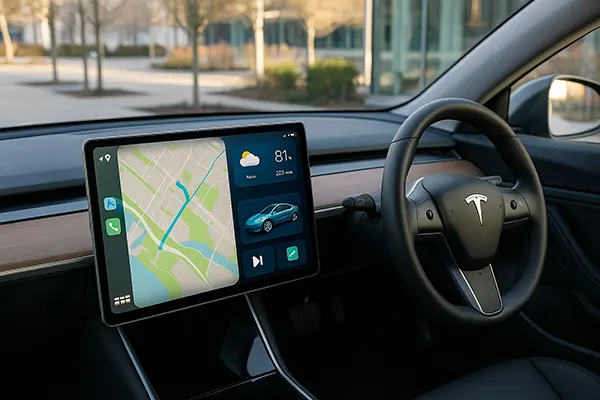Apple CarPlay in 2025: New Capabilities, Electric Vehicle Integration and Competition with Android Auto

Apple CarPlay in 2025 represents a more advanced and versatile in-car system that reflects the growing role of digital frameworks within modern vehicles. The updated version focuses on improved personalisation, deeper access to vehicle functions and wider collaboration with electric car manufacturers. These developments highlight Apple’s intention to create a stable ecosystem that adapts to different models and user expectations.
Expanded Interface and Enhanced Personalisation
The 2025 version of Apple CarPlay features a redesigned interface that automatically adjusts to different screen configurations used by vehicle brands. Car makers now apply multi-display layouts with varying aspect ratios, and the refreshed system adapts seamlessly without requiring manual adjustments. This shift ensures consistency across dashboards and improves visibility of essential driving information.
The updated CarPlay also incorporates extended widget functionality, enabling drivers to arrange navigation, media, weather and battery tools across several displays. The widgets display real-time information and are designed to offer quicker access to frequently used functions. This approach reduces the number of menu transitions required while driving, which contributes to safer interactions.
Another improvement includes enhanced settings synchronisation. User preferences for playlists, map routes and interface layout transfer automatically between paired vehicles, allowing a consistent experience across different models. This optimisation is particularly useful for users who frequently use multiple cars or rental vehicles.
Vehicle Controls and System-level Integration
Deeper integration with in-car systems forms an important part of CarPlay’s development in 2025. The system now provides access to parameters such as climate zones, heated seats and internal lighting. These features can be controlled directly from the CarPlay interface, reducing dependence on brand-specific menus and creating a unified control environment.
Manufacturers collaborating with Apple have expanded the list of compatible sensors and internal systems that can share data with the interface. Fuel level, tyre pressure, energy regeneration and speed information can now be presented within CarPlay when supported by the vehicle. This allows drivers to access essential status indicators without navigating separate menus.
Security also received attention, with Apple applying encrypted communication layers between the mobile device and the vehicle. The strengthened architecture is intended to reduce risks associated with unauthorised access and protect data exchanges between modules. These measures align with ongoing industry focus on cybersecurity in connected vehicles.
Integration with Electric Vehicles and Charging Infrastructure
CarPlay’s enhanced compatibility with electric vehicles in 2025 addresses the rapid growth of EV adoption across global markets. The system displays real-time battery levels, estimated remaining range and charging speed directly within the dashboard. The data is provided without the need to switch to manufacturer-specific systems, ensuring a uniform experience across brands.
Route planning has also been improved to include detailed charging station information. Drivers receive suggestions based on available connectors, expected waiting times and supported charging speeds. This upgrade helps users make informed decisions about charging stops and avoids incompatible locations.
CarPlay additionally incorporates smart charging recommendations powered by predictive algorithms. These indicators consider temperature, route elevation and estimated consumption to calculate optimal energy use. Manufacturers using this feature aim to enhance efficiency and assist drivers in planning long-distance travel with greater accuracy.
Support for EV-specific Functions
CarPlay now supports features tailored directly to electric car behaviour. For instance, the system can display regenerative braking efficiency and track driver habits to suggest adjustments that may increase range. The additional information assists users who want to optimise their driving style.
Another EV-oriented tool is the preconditioning controller. Drivers can set cabin temperature or battery preheating directly through CarPlay, provided the vehicle manufacturer enables this functionality. Such features are especially relevant in regions with low temperatures, where preconditioning significantly affects driving efficiency and comfort.
Charging session monitoring has been improved as well. CarPlay provides updates on cost estimates, energy delivered and predicted charging completion time. These indicators help users keep track of expenses and maintain awareness of charging progress without relying solely on third-party applications.

Competition with Android Auto and Market Dynamics
The competition between Apple CarPlay and Android Auto continues to intensify in 2025 as both systems evolve. CarPlay’s enhancement towards deeper vehicle integration is viewed as a strategic response to Android Auto’s progress in customisable interfaces and integration with Google-based navigation technologies. Users now benefit from more balanced products, each offering unique strengths.
Manufacturers increasingly choose to support both systems equally, giving customers flexibility when selecting their preferred smartphone environment. Many brands aim to reduce reliance on proprietary infotainment solutions by allowing external systems to access key functions. This approach streamlines development costs and creates a more unified experience for drivers.
Market trends indicate that the rivalry motivates both companies to refine their software continuously. Apple and Google update their systems to maintain compatibility with new vehicle models and emerging standards. These improvements influence the broader automotive ecosystem, encouraging long-term innovation in digital interfaces and expanding cross-brand usability.
Future Developments and Industry Trends
Industry analysts expect Apple to continue strengthening its presence in the automotive sector by expanding partnerships with electric car manufacturers. Further developments may include advanced diagnostic features, deeper access to power management systems and integration with future autonomous driving modules. These trends reflect Apple’s goal to embed its ecosystem more firmly into modern vehicles.
Developers working with automotive brands anticipate more flexible display arrangements in future CarPlay updates. As vehicle interiors adopt new screen shapes and interactive surfaces, Apple is likely to adjust its design standards to maintain a seamless user experience. This direction aligns with broader automotive design tendencies towards multi-panel dashboards.
There is also interest in the potential adoption of satellite connectivity in future versions of CarPlay. While not confirmed, such features could support navigation and communication in remote locations with limited mobile coverage. Industry experts note that this possibility would require collaboration with telecommunication partners and appropriate hardware capabilities in upcoming iPhone models.
